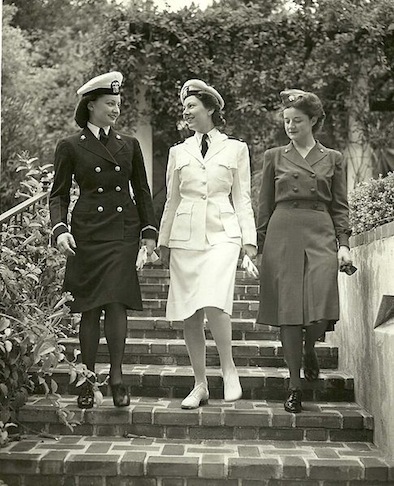Looking Good In Wartime, Part One
First published on the Centre for Youth Literature Literature website, Inside A Dog, in 2012.
It was a bit of a challenge, dressing well during the Second World War. To illustrate why, here’s an excerpt from an early draft of The FitzOsbornes at War:
“Julia and I went to a fashion show this morning, featuring the new official ‘Utility’ outfits. Of course, they are all very plain, to conserve both materials and labour – no more than three buttons per item, only one or two pleats, no lace trimmings or turned-back cuffs, no appliqué or embroidery, and the skirts are rather short, with hardly any hem. Still, they are beautifully cut and most importantly, new. I know I was lucky to own so many clothes when the war began, but some of them seem a bit schoolgirlish and old-fashioned now, and they’re all starting to look very shabby. There’s only so much one can do as far as re-dyeing fabrics and swapping buttons and letting down hems – sometimes a girl just longs to wear something crisp and bright and unfamiliar. So we all sat there at the show (in our baggy tweed suits and grey-seamed blouses), and practically salivated over the display. Just my luck I’ve recently had to use up eleven precious clothes coupons on new shoes and some socks, so I really can’t buy anything else for a while. But Julia said she’d found some lengths of curtain material, including a very pretty pale blue cotton, so she’s going to make me a short, plain summer frock from it. I’ll give her the pearl buttons from my old white blouse that had an unfortunate encounter with a leaky pen, and I’ll see if I can find a lace handkerchief for a little collar.”

German U-boats were sinking the ships that brought supplies to England, and any available materials were requisitioned by the military, so clothes for civilians were in short supply. As a result, the British government brought in clothes rationing. At first, everyone was allowed sixty-six coupons each year, although two years later, this had fallen to a mere forty coupons. You had to pay for the clothes as well as hand over the correct number of clothing coupons, and there were complicated rules about how many coupons were needed for each garment. For example, a woman’s woollen dress required eleven coupons, but a cotton dress only seven coupons. Women’s pyjamas needed eight coupons, but a nightdress only six. Shoes needed seven coupons, stockings needed two coupons and ankle socks needed only one coupon. Balls of knitting wool and lengths of fabric were also rationed. Some women made dresses out of sheets and furnishing fabrics, but soon even these were rationed, so the really creative types used torn parachutes (which were made from silk in those days), old blankets and pillowcases. Have a look at this Ministry of Supply film clip, part of the ‘Make Do and Mend’ campaign, to see how resourceful women were. [The photo above is of some volunteers from the Women of the University War Work Group in Brisbane, 1942.]
In 1943, the first ‘Utility’ clothes went on sale. The name wasn’t very appealing, but the clothes had been designed by famous fashion designers including Hardy Amies, Edward Molyneux, Norman Hartnell and Victor Stiebel, and the outfits turned out to be very popular.

Of course, some women were in uniform because they’d enrolled in the armed services or were working as nurses (the photo above shows three US Navy nurses in 1944). The Wrens (the British women’s navy) were especially popular with women, with some debutantes confessing that they’d only enrolled in it because the uniform was so glamorous. But then, other women, doing equally important war work in munitions factories, wore distinctly unglamorous blue overalls and cotton head scarves.
If you’re interested in 1940s fashions, check out this website, which is filled with pictures of everyday clothes, wedding dresses, hats, hairstyles and more.
Next: Looking Good in Wartime, Part Two



